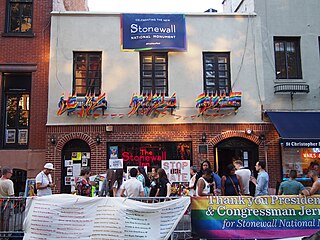
Sexual orientation is an enduring personal pattern of romantic attraction or sexual attraction to persons of the opposite sex or gender, the same sex or gender, or to both sexes or more than one gender. Patterns are generally categorized under heterosexuality, homosexuality, and bisexuality, while asexuality is sometimes identified as the fourth category.

The Kinsey scale, also called the Heterosexual–Homosexual Rating Scale, is used in research to describe a person's sexual orientation based on one's experience or response at a given time. The scale typically ranges from 0, meaning exclusively heterosexual, to a 6, meaning exclusively homosexual. In both the male and female volumes of the Kinsey Reports, an additional grade, listed as "X", indicated "no socio-sexual contacts or reactions" (asexuality). The reports were first published in Sexual Behavior in the Human Male (1948) by Alfred Kinsey, Wardell Pomeroy, and others, and were also prominent in the complementary work Sexual Behavior in the Human Female (1953).

Asexuality is the lack of sexual attraction to others, or low or absent interest in or desire for sexual activity. It may be considered a sexual orientation or the lack thereof. It may also be categorized more widely, to include a broad spectrum of asexual sub-identities.

Biphobia is aversion toward bisexuality or people who are identified or perceived as being bisexual. Similarly to homophobia, it refers to hatred and prejudice specifically against those identified or perceived as being in the bisexual community. It can take the form of denial that bisexuality is a genuine sexual orientation, or of negative stereotypes about people who are bisexual. Other forms of biphobia include bisexual erasure. Biphobia may also avert towards other sexualities attracted to multiple genders such as pansexuality or polysexuality, as the idea of being attracted to multiple genders is generally the cause of stigma towards bisexuality.
Heterosexism is a system of attitudes, bias, and discrimination in favor of heterosexuality and heterosexual relationships. According to Elizabeth Cramer, it can include the belief that all people are or should be heterosexual and that heterosexual relationships are the only norm and therefore superior.
Sexual identity refers to one's self-perception in terms of romantic or sexual attraction towards others, though not mutually exclusive, and can be different from romantic identity. Sexual identity may also refer to sexual orientation identity, which is when people identify or dis-identify with a sexual orientation or choose not to identify with a sexual orientation. Sexual identity and sexual behavior are closely related to sexual orientation, but they are distinguished, with identity referring to an individual's conception of themselves, behavior referring to actual sexual acts performed by the individual, and sexual orientation referring to romantic or sexual attractions toward persons of the opposite sex or gender, the same sex or gender, to both sexes or more than one gender, or to no one.
Monosexuality is romantic or sexual attraction to members of one sex or gender only. A monosexual person may identify as heterosexual or homosexual. In discussions of sexual orientation, the term is chiefly used in contrast to asexuality and plurisexuality. It is sometimes considered derogatory or offensive by the people to whom it is applied, particularly gay men and lesbians. In blogs about sexuality, some have argued that the term "monosexuality" inaccurately claims that homosexuals and heterosexuals have the same privilege. However, some have used the term "monosexual privilege", arguing that biphobia is different from homophobia.
A sexual minority is a demographic whose sexual identity, orientation or practices differ from the majority of the surrounding society. Primarily used to refer to lesbian, gay, bisexual, or non-heterosexual individuals, it can also refer to transgender, non-binary or intersex individuals.

Homophobia encompasses a range of negative attitudes and feelings toward homosexuality or people who identify or are perceived as being lesbian, gay or bisexual. It has been defined as contempt, prejudice, aversion, hatred, or antipathy, may be based on irrational fear and may sometimes be attributed to religious beliefs.

Ego-dystonic sexual orientation is a highly controversial mental health diagnosis that was included in the American Psychiatric Association's Diagnostic and Statistical Manual of Mental Disorders (DSM) from 1980 to 1987 and in the World Health Organization's (WHO) International Classification of Diseases (ICD) from 1990 to 2019. Individuals could be diagnosed with ego-dystonic sexual orientation if their sexual orientation or attractions were at odds with their idealized self-image, causing anxiety and a desire to change their orientation or become more comfortable with it. It describes not innate sexual orientation itself, but a conflict between the sexual orientation a person wishes to have and their actual sexual orientation.
Sexual orientation discrimination is discrimination based on a person's sex, sexual orientation, gender identity, or pregnancy.
Gregory M. Herek is a researcher, author, and professor of psychology at the University of California at Davis (UCD). He has conducted extensive research on prejudice against sexual minorities, and coined the term sexual prejudice as a replacement for homophobia to describe this phenomenon. Herek argued that using the term homophobia incorrectly assumes that negative responses to lesbian, gay, and bisexual people are founded in pathological, irrational fear, whereas psychological research indicates they are more accurately regarded as a form of prejudice. Herek is an openly and prominent gay psychologist. Herek is considered one of the most influential scholars of sexual minorities.

Christian denominations have a variety of beliefs about sexual orientation, including beliefs about same-sex sexual practices and asexuality. Denominations differ in the way they treat lesbian, bisexual, and gay people; variously, such people may be barred from membership, accepted as laity, or ordained as clergy, depending on the denomination. As asexuality is relatively new to public discourse, few Christian denominations discuss it. Asexuality may be considered the lack of a sexual orientation, or one of the four variations thereof, alongside heterosexuality, homosexuality, bisexuality, and pansexuality.

Sexual stigma is a form of social stigma against people who are perceived to be non-heterosexual because of their beliefs, identities or behaviors. Privileged individuals, or the majority group members, are the main contributors of placing sexual stigmas on individuals and their minority group. It is those who hold a higher status that determine within a society which groups are deemed unworthy of a higher status by labeling their specific actions or beliefs. Stereotypes are then produced which further the debilitating effects of the label(s) placed on group members with non-heterosexual beliefs or practices.

Discrimination against gay men, sometimes called gayphobia, is a form of homophobic prejudice, hatred, or bias specifically directed toward gay men, male homosexuality, or men who are perceived to be gay. This discrimination is closely related to femmephobia, which is the dislike of, or hostility toward, individuals who present as feminine, including gay and effeminate men.

The following outline offers an overview and guide to LGBTQ topics:
Sexual diversity or gender and sexual diversity (GSD), refers to all the diversities of sex characteristics, sexual orientations and gender identities, without the need to specify each of the identities, behaviors, or characteristics that form this plurality.
Queer erasure refers to the tendency to intentionally or unintentionally remove LGBT groups or people from record, or downplay their significance, which includes lesbian, gay, bisexual, transgender, and queer people. This erasure can be found in a number of written and oral texts, including popular and scholarly texts.
Discrimination against asexual people, also known as acephobia or aphobia when directed at aspec people, encompasses a range of negative attitudes, behaviours, and feelings toward asexuality or people who identify as part of the asexual spectrum. Negative feelings or characterisations toward asexuality include dehumanisation, the belief that asexuality is a mental illness, that asexual people cannot feel love, and the refusal to accept asexuality as a genuine sexual orientation. Asexuality is sometimes confused with celibacy, abstinence, antisexualism, or hyposexuality. Since discrimination on the basis of sexual orientation belongs under the wider social concept of kyriarchy, any acephobic acts due to intentional discrimination are a form of kyriarchy.

Allosexuality is the ability to experience sexual attraction. The term is often used to describe persons who are not asexual, or the lack of identification with asexuality. Someone who experiences allosexuality is allosexual, sometimes shortened to allo. Other terms to describe non-asexual people include zedsexual, or simply sexual.